Rhomboid Muscle Pain
What is Rhomboid Muscle Pain?
Rhomboid muscle pain refers to discomfort or soreness in the rhomboid muscles, which are a pair of diamond-shaped muscles located in the upper back, between the shoulder blades. These muscles play a crucial role in shoulder and upper back movement, helping to retract the scapulae (shoulder blades) towards the spine.
Various factors can contribute to rhomboid muscle pain, including poor posture, overuse, muscle strain, trauma, or underlying medical conditions. Individuals who engage in repetitive activities, such as prolonged sitting at a desk or frequent lifting, may be more susceptible to developing rhomboid muscle pain.
Symptoms of rhomboid muscle pain often include localized discomfort, stiffness, and sometimes sharp or burning sensations between the shoulder blades. Proper diagnosis and treatment may involve a combination of rest, stretching exercises, posture correction, and, in some cases, medical intervention.
Understanding the causes and symptoms of rhomboid muscle pain is essential for effective management and prevention, as addressing underlying factors can contribute to long-term relief and improved overall musculoskeletal health. If persistent or severe pain is experienced, seeking professional medical advice is recommended for a comprehensive assessment and personalized treatment plan.
Anatomy
The rhombus-shaped rhomboid muscles also referred to as the rhomboids, are connected to the scapula. On either side of the upper back, there are two rhomboid muscles:
- Rhomboid Major
- Rhomboid Minor
The rhomboid muscles are a pair of diamond-shaped muscles located deep in the trapezius in the upper back. They play a crucial role in shoulder girdle stability and movement.
Structure and Anatomy:
The rhomboid major and rhomboid minor are the two separate muscles that make up the rhomboid muscles.
- Rhomboid Major: The rhomboid major, the bigger and thicker of the two, enters into the medial border of the scapula beneath the scapula’s spine after emerging from the thoracic vertebrae T2 to T5.
- Rhomboid Minor: Smaller and thinner, the rhomboid minor arises from the ligamentum nuchae and the spinous processes of the seventh cervical vertebra (C7) and the first thoracic vertebra (T1) and attaches to the medial border of the scapula above the spine of the scapula.
Function:
The rhomboid muscles work together to perform the following key functions:
- Retraction of the Scapula: They pull the scapula backward, moving it closer to the spine. This action is essential for maintaining good posture and preventing winging of the scapula.
- Elevation of the Scapula: They elevate the scapula, lifting it upwards during movements like reaching, overhead throws, and shoulder shrugs.
- Stabilization of the Scapula: They provide stability to the scapula, ensuring proper alignment and support during shoulder movements. This stability is crucial for preventing shoulder pain and injuries.
The shoulder girdle, which is made up of these and other muscles, stabilizes your shoulder blade and shoulder. Moreover, the rhomboid muscles
- Pull back your shoulder blade.
- Raise and turn your shoulder blade.
- Assist you in raising your arm above your head
- Assist you in throwing
- Assist you in pulling
- assist you in turning your torso
How to identify pain in the rhomboid muscle
You might experience a strain, a shooting pain, or a spasm in this region if you have rhomboid pain. Additional signs of pain in the rhomboid muscles could be:
Discomfort in the upper back region a popping or grinding sound made when the shoulder blade is moved
pain or difficulty moving the affected muscle; edema, knots, and tightness surrounding the affected muscle; pain during breathing
In addition to the mid-upper back, the backs of the shoulders and the area between the spine and the shoulder blade can all experience pain due to rhomboid muscle strain. Additionally, the area above the shoulder blade feels its presence.
Rhomboid Muscle Pain Causes
Numerous factors, such as an injury, strain, or overuse, can result in pain in your rhomboid muscle, upper back, or shoulders.
Muscle rhomboid pain can result from:
- Poor posture, particularly if you spend a lot of time slouching over a computer
- motions of rowing
- Pulling actions
- Repeated actions
- Throwing motions
- Press-ups
- Using weights to strengthen your back and shoulders
- Injury
The rhomboid muscle can also hurt due to specific medical conditions. The surrounding muscles may be affected if you have shoulder joint issues.
Myositis. Inflammation and muscle weakness may result from this condition. Usually, your shoulders and hips are where it first shows up.
Rheumatic polymyalgia. This is a disorder that produces stiffness and pain in the hips and shoulders. Usually, it affects adults over 50. Both sides of your body may be affected by the pain and stiffness, which could be worse in the morning.
The arthritis rheumatoid. Your immune system attacks your joints as a result of this autoimmune disease. It typically results in severe pain and swelling and may cause abnormalities in the joints. Your rhomboid muscles may be impacted by rheumatoid arthritis, which can also affect your shoulders.
Arthritic bone. Loss of cartilage is a result of the degenerative bone disease osteoarthritis. Pain and stiffness may result from this. It’s possible that your shoulder is immobile, which can make the nearby muscles uncomfortable.
Shoulder and arm pain may result from overusing the rhomboid muscle. Sports like rowing, tennis, and golf can aggravate this region. This kind of pain can also be caused by jobs and activities that require you to lift heavy objects, carry heavy backpacks and bags, and extend your arms over your head for extended periods of time.
A collection of muscles in the upper back, in between the shoulder blades, are called the rhomboids. These muscles may cause pain and discomfort if they become strained or unbalanced. Among the frequent reasons for rhomboid pain are:
- Bad Posture: Slouching or prolonged sitting can weaken the rhomboid muscles, which can cause discomfort.
- Muscle Imbalances: One of the causes of rhomboid pain may be a weakness in specific muscle groups, such as the upper back or chest.
- Overuse or Repetitive Motions: The rhomboid muscles can become strained by repetitive motion-based activities such as typing or rowing.
- Trauma or Injury: The rhomboid region may experience sprains or strains of muscles due to accidents or abrupt movements.
Symptoms of Rhomboid Muscle Pain
The typical presentation of rhomboid muscle pain is aches or tension in the upper back, specifically between the shoulder and the spine. Among the signs of rhomboid muscle soreness are:
- Aching pain
- rigidity
- Tightness
- Grasping
- Taking aim at suffering
- tingling numbness
- Needles and pins
- Pain caused by popping or clicking noises
- breathing that hurts
Diagnosis of Rhomboid Muscle Pain
Diagnosing rhomboid muscle pain typically involves a physical examination and a medical history review. Imaging tests may be ordered in some cases to rule out other potential causes of upper back pain.
Physical Examination
As part of the physical examination, the medical professional will evaluate:
- Posture: They will observe your posture while standing and sitting, looking for signs of slouching or rounded shoulders that could strain the rhomboid muscles.
- Range of motion: They will check the range of motion in your shoulders, neck, and spine to identify any limitations or pain with movement.
- Palpation: They will palpate (feel) the rhomboid muscles for tenderness, tightness, or trigger points. Hypersensitive spots in the muscle called trigger points can result in transferred pain.
Medical History
The healthcare provider will also review your medical history, asking questions about:
- Occupation or activities: They may inquire about your job or activities that could overuse or strain the rhomboid muscles, such as rowing, swimming, or throwing.
- Previous injuries: They may ask about any past injuries to your upper back, shoulders, or neck.
- Pain characteristics: They will ask about the location, severity, and duration of your pain, as well as any aggravating or relieving factors.
Imaging Tests
In some cases, imaging tests may be ordered to rule out other underlying causes of upper back pain, such as:
- X-rays: These can reveal bone abnormalities that could be contributing to pain.
- MRI scans: These can provide more detailed images of muscles, tendons, and ligaments, helping to identify soft tissue injuries.
Differential Diagnosis
The healthcare provider will consider other possible causes of your upper back pain, such as:
- Trapezius muscle strain: The trapezius is a large muscle that extends from the neck to the middle back. Strain or injury to this muscle can cause pain in the upper back, shoulders, and neck.
- Cervical spine sprain or strain: A sprain or strain in the ligaments or muscles of the neck can also cause pain in the upper back.
- Rotator cuff injury: Injuries to the tendons or muscles of the rotator cuff, which stabilizes the shoulder joint, can cause pain in the upper back.
- Osteoarthritis: Arthritis in the facet joints of the spine can cause pain in the upper back and neck.
Treatment for rhomboid muscle pain
A minor rhomboid strain may recover in a matter of weeks. It may take longer for an injury, strain, or tear that is more severe to heal.
You can take the following actions at home to assist in managing your pain:
- Apply ice to your shoulder.
- If there is no swelling, switch between ice and heat packs.
- Use painkillers such as acetaminophen
- Use nonsteroidal anti-inflammatory medications
- Maintain a dissatisfied posture and perform mild stretches.
- Maintain a straight posture.
- Apply a topical analgesic.
- Get a massage
Taking it easy and avoiding activities that aggravate your rhomboid muscles will speed up your recovery. The first course of treatment is the RICE technique.
Relax. Take as much time as you can to rest your arms and shoulders. Avoid engaging in any activity that requires these muscles.
Ice. Many times a day, apply ice to your shoulder for 20 minutes at a time. Ice the affected area as soon as possible after an injury or strain, as this is especially important.
compression. To lessen swelling, apply a compression bandage to the affected area.
A rise in elevation. When you’re sleeping or lying down, use pillows to keep your chest and shoulder raised.
Painkillers available over the counter can help reduce inflammation and discomfort. These include acetaminophen (Tylenol) and ibuprofen (Advil and Motrin IB).
Topical pain relievers, such as gels, creams, and sprays, can also be applied to the area in question. Topical analgesics with a lower risk of side effects include salicylates (Bengay, Icy Hot) and diclofenac (Voltaren, Solaraze). This is because the medication avoids the gastrointestinal system and is absorbed into the blood in smaller amounts.
To lessen pain and inflammation, you might think about applying essential oils that have been diluted in a carrier oil. Certain oils have the potential to alleviate aching muscles.
You might want to use heat after icing your shoulder for a few days. A heated compress or heating pad are options. It is possible to switch between hot and cold therapy.
You might benefit from visiting a physical therapist or physiotherapist if you’ve tried the treatment for your rhomboid muscle pain but it’s not getting better. They can provide you with exercises to help with your shoulder pain and keep it from coming back.
Physiotherapy Treatment
An approved physiotherapist can create a thorough treatment plan specific to meet your unique requirements. The following are some essential techniques for treating rhomboid pain.
A comprehensive evaluation to determine the underlying cause of your rhomboid pain is the first step. To identify the cause of your discomfort, the physiotherapist will assess your range of motion, muscle strength, and posture, and conduct any necessary tests.
Manual Therapy Methods:
Myofascial release, massage, and soft tissue mobilization are examples of manual therapies that can be used to ease pain and release tense muscles.
It is also possible to restore appropriate movement and alignment in the upper back and shoulder region by using joint mobilization and manipulation.
Postural Correction and Ergonomics:
The physiotherapist will offer advice on how to stand, sit, and lift objects using a suitable posture.
They might suggest making ergonomic adjustments to your place of employment to ensure ideal alignment and lessen the strain on your rhomboid muscles.
Exercises for Strengthening and Stretching:
Exercises with specific goals are necessary for regaining muscle balance and strength.
The physiotherapist will recommend exercises aimed at strengthening the rhomboids and other secondary muscles.
In order to increase flexibility and relieve tension in the upper back and shoulder area, stretches will also be included.
Therapeutic Modalities:
Pain, inflammation, and tissue healing can all be achieved with the use of modalities such as electrical stimulation, ultrasound, thermotherapy, and cryotherapy.
Education and Self-Care:
During physiotherapy sessions, patients can pick up knowledge on appropriate body mechanics, ways to avoid injuries, and self-care practices.
To help you heal and avoid more pain, the physiotherapist might offer advice on self-massage methods, at-home workouts, and lifestyle changes.
Your everyday activities may be impacted by rhomboid pain, which can be a chronic and destroying condition. However, you can get rid of this pain with the help and knowledge of a qualified physiotherapist. With targeted exercises and therapies, posture correction, and addressing the underlying causes, physiotherapy can help you regain function, strength, and flexibility in your upper back. See a physiotherapist and start your journey to recovery to take the first step towards a future free from pain.
stretches and workouts to reduce pain
You can do a variety of stretches and exercises to ease the pain in your rhomboid muscles. These exercises can speed up your healing process and stop pain from coming back.
Make sure the exercises don’t cause you any pain or strain. It might be necessary for you to take a short break before starting these exercises. Steer clear of pushing oneself too hard or too quickly.
You can also experiment with various methods of muscle stretching, such as:
A tennis ball.
A tennis ball should be placed beneath your shoulder as you lie on the ground. Roll your shoulder across the ball in a gentle back-and-forth motion. Repeat while shifting positions.
Foam roller.
Roll your shoulder over a foam roller while lying on the ground. This will assist in massaging and releasing the muscles.
Self-massage equipment.
You can purchase a device that runs on batteries or electricity to massage your shoulder. Avoid using high settings that could cause too much pain.
Warm-up movements.
Warming up and stretching before and after exercise can help protect your muscles if you work out or play sports. Give your muscles a break and concentrate on using a different set of muscles if they are sore from a recent workout.
Taking breaks.
Take frequent breaks if you spend most of your day sitting at a computer for work. If you spend most of your day at a computer for work, take regular breaks.
Improved alignment.
Look for a tall-backed office chair and recline the chair all the way back, pressing your shoulders against it. Maintaining proper posture can also be aided by placing your feet on a stool.
Exercise for rhomboid muscle pain
1. Squeeze your shoulder blades
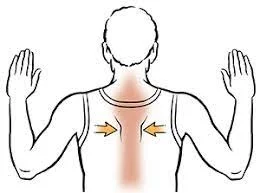
Place your arms by your sides while you sit or stand.
Squeeze your shoulder blades together by drawing them back.
Maintain this stance for a minimum of five seconds.
Relax and carry on.
Keep going for a minimum of a minute.
2. Rhomboid Stretch
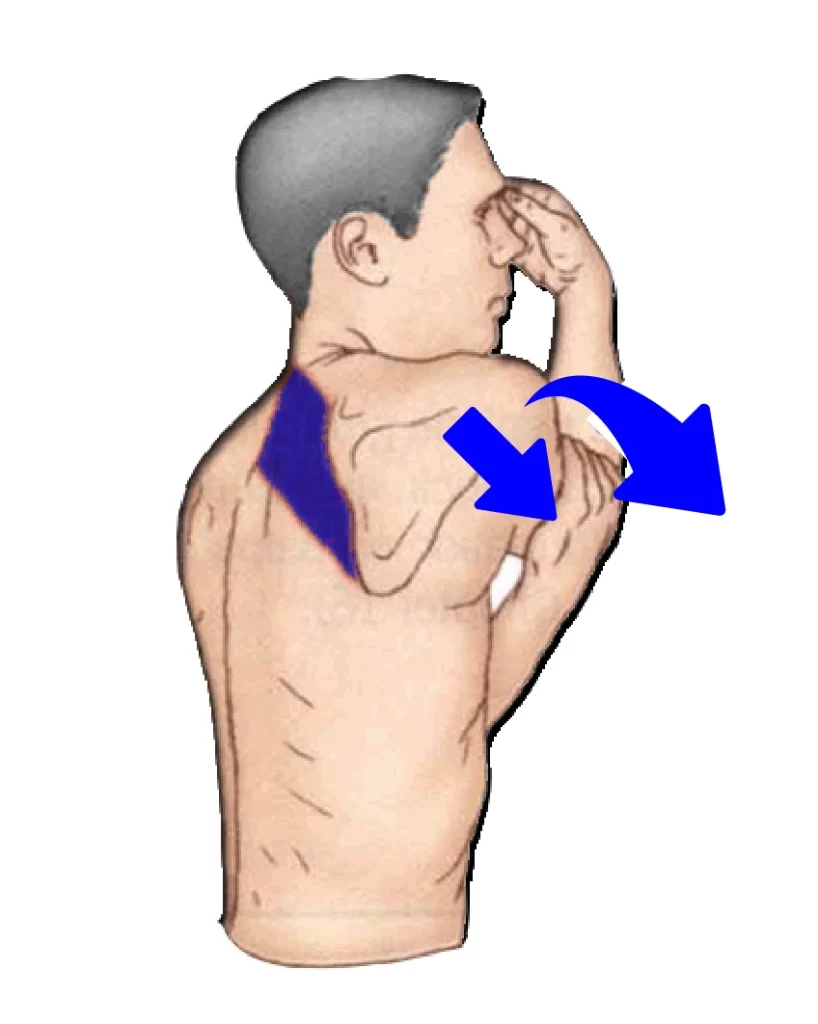
Place your right hand over your left as you stack your hands.
Feel a light stretch between your shoulder blades by slowly reaching forward and spreading your arms out in front of you.
Take a 30-second break from this pose.
Perform the other side.
Repeat this stretch twice, once for each side.
3. Side arm stretch
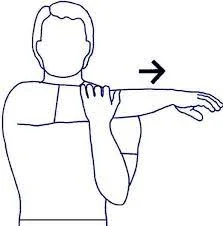
Raise your left arm to shoulder height and extend it across the front of your body.
You can either use your right arm to hold your left hand or bend your right arm with the palm facing up and let your left armrest in your elbow crease.
For thirty seconds, maintain this posture.
Perform the other side.
Stretch each side three to five times.
4. Upper back and neck stretch

With your palms facing forward, extend your arms in front of you at chest level while connecting your fingers.
Draw your chin into your chest and gently bend your neck.
For thirty seconds, maintain this posture.
Then raise your head and look up as you take a breath.
Bend your neck and press your chin back into your chest as you release the breath.
For thirty seconds, maintain this movement by following your breath.
Let go of the pose, relax for a minute, and then do it once or twice more.
5. Neck rotations

Whether sitting or standing, align your head, neck, and spine in a straight line.
As you release your breath, slowly turn your head to the right.
Try not to strain as you go as far as you can.
Take a deep breath and maintain this posture for thirty seconds.
Inhale to return to the starting position. On the other side, repeat.
Repeat on both sides three times.
6. Cow Face Pose
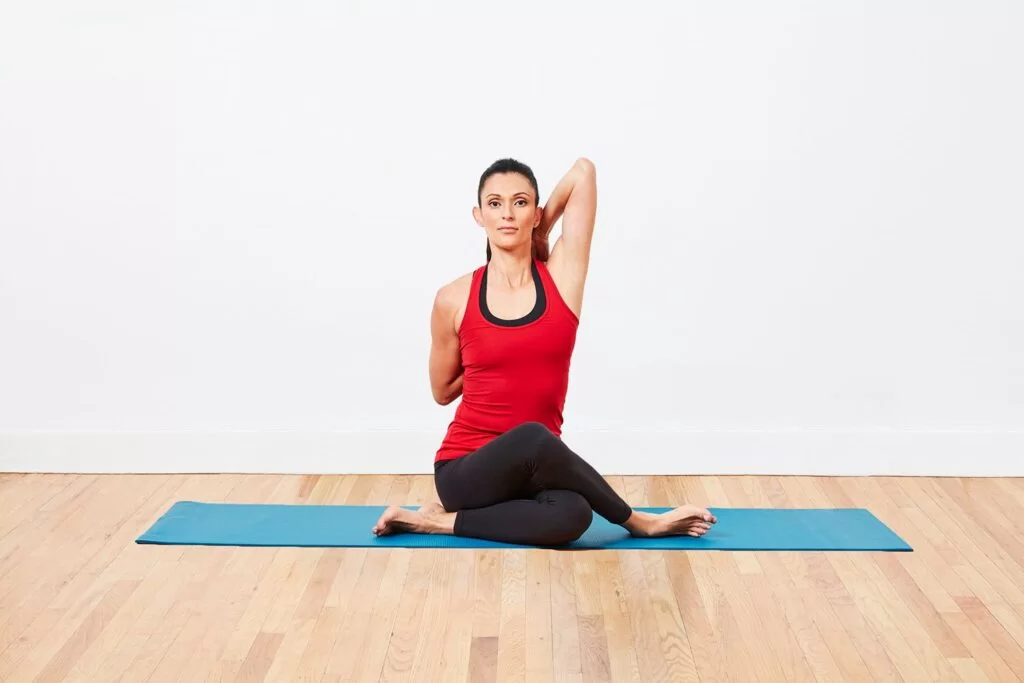
With your left arm extended toward the ceiling, take a seat.
Bring your hand to your back and bend your left elbow.
Pull your left elbow slightly to the right with your right hand.
Bend your right elbow and bring your right fingertips to clasp your left fingertips to deepen the pose.
If you are unable to reach it, you can use a towel or rope.
Stay in this posture for roughly thirty seconds.
Next, work on the other side.
7. Locust Pose( Salabhasana)

With your arms by your sides and your palms facing up, take a stomach position.
Permit your heels to splay to one side.
Lay your forehead down on the ground gently.
Raise your arms, chest, and head as high as possible.
Raise your legs to extend the pose further.
Press your pelvis, stomach, and lower ribs into the floor to further extend the stretch.
Aim directly ahead or slightly up.
Spend roughly thirty seconds in this position.
After releasing the pose and taking a brief break, perform the pose once or twice more.
Strengthening exercise
Your posture will improve and your rhomboid muscles will strengthen with these five exercises.
1. Lateral prone elevation

On a mat or bench, lie flat on your stomach. Grasp a small dumbbell in both hands. Your forehead should be on the mat. Maintain a shoulder-width gap between your feet. Keep your arms outstretched and completely relaxed. Face your palms in the direction of your body.
Raise your arms to your sides until your arms are parallel to the floor and your elbows are shoulder height. Let out a breath. Throughout the exercise, maintain your arms fully extended and perpendicular to your torso.
Squeeze your shoulder blades together and hold for one count once you’ve reached shoulder height. Only your arms should be up; nothing else should. Isolating your upper back is the aim. Breathe in, then gradually return the dumbbells to their starting position. Eight times over, repeat.
2. Front gives a thumbs-up
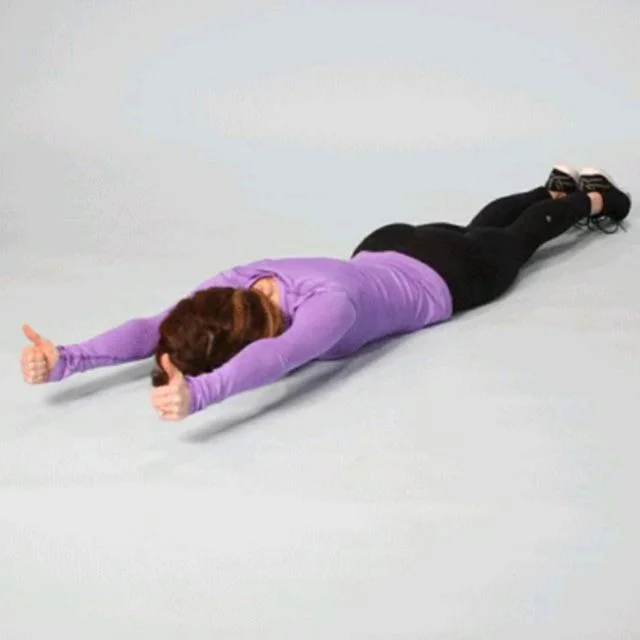
Place your forehead down and lie on your stomach on a mat or bench. Maintain a shoulder-width gap between your feet. Raise your arms to the ceiling, fully extended, and raise your thumbs to the sky. This is where you should put your feet up.
After letting out a breath, extend your arms straight. Hold them out to their maximum length without raising your head off the mat. You should only use your shoulders and upper back for this exercise, so keep your lower body and torso glued to the mat.
As you raise yourself as high as you can without sacrificing form, contract the muscles in the space between your shoulder blades. Maintain this posture for a single count.
Breathe in, then slowly return to your starting posture, keeping your arms fully extended. Do this fifteen times.
Next phase
You can hold dumbbells in your hands in place of pointing your thumbs up for a more difficult variation of this exercise.
3. Retraction of the scapula
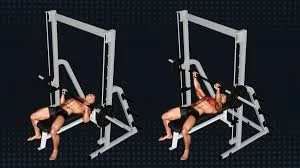
For this exercise, use an assisted pullup machine or a Smith machine.
Place your chest exactly under the bar while seated on the floor. Set your knees at a 90-degree angle and space your feet shoulder-width apart.
Keeping your hands palms away from you, contract your core and grab the bar. Maintaining a straight line through your shoulders, torso, hips, and knees, pull yourself up.
Squeeze your shoulder blades together, pushing them down and back, while keeping your chest open, until you can clearly raise yourself two to three inches above the bar. Don’t argue or straighten up. Allow me to retract this one time.
Continue breathing, let go of the contraction, and return to the beginning position. Do this fifteen times.
4. Flying delts in the rear

With your feet flat on the ground, sit on a bench. Be sure to space your knees 90 degrees apart. With your palms facing outward, grasp a dumbbell in each hand while hunching forward at the hips. The area between your legs and the bench is where the dumbbells should be resting. With your arms fully extended to your sides, place your stomach on your thighs.
Inhale out and contract your core. Sit up straight, lift your torso away from your thighs, and perform a reverse fly in one motion.
One time, while sitting tall and your palms at shoulder height, rotate your wrists from the ceiling to the floor and back up again. You must therefore maintain this posture for an additional count. You’ll tighten your shoulder blades down and back and strengthen your forearms.
Breathe in, turn the steps around slowly, and lower the dumbbells to your starting position so that your torso is resting on your thighs. Do this twelve times.
5. Wall slides with scapula
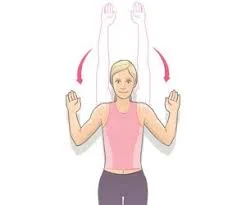
Put your back to a wall. To prevent a back arch, maintain a tilt in your pelvis. Press your butt, back, and head firmly against the wall. To prevent your legs from becoming totally locked, give your knees a small bend. Your palms should be facing away from the wall as you fully extend your arms straight above you.
Squeeze your midback muscles as you slide your arms down toward your shoulders, keeping your back straight and your chest open. Maintain pressure against the wall with your back, wrists, elbows, and palms. A contraction should start to feel immediately.
Remember that if you are tight or have poor posture, this exercise will be challenging for you. When your elbows are just below shoulder height, stop.
Maintain this posture for a single count. After taking a breath, raise your arms to your starting position so that nothing is protruding from the wall. Do this fifteen times.
Advance technique
KT tapping for rhomboid muscle pain
Tapping, also known as acupressure or trigger point therapy, is a technique that involves applying pressure to specific points on the body to relieve pain and promote healing. It is a safe and effective treatment for rhomboid muscle pain.
There are a few different ways to tap for rhomboid muscle pain. You can use your fingers, knuckles, or a blunt object, such as a pen or pencil. Apply firm pressure to the trigger point for 30-60 seconds. You may feel a twitch or release as the trigger point relaxes
Kinesiology taping, also known as KT tape, is a therapeutic tape that is used to relieve pain, reduce inflammation, and improve muscle function. It is a popular treatment for rhomboid muscle pain, as it can help to provide support and stability to the muscles.
How does kinesiology taping work for rhomboid muscle pain?
Kinesiology taping works by providing proprioceptive feedback to the muscles. The body’s awareness of its own position and movement is known as proprioception. When kinesiology tape is applied to the skin, it creates a gentle pressure that sends signals to the brain about the position of the muscles. This feedback can help to reduce muscle tension and improve muscle function.
How to apply kinesiology tape for rhomboid muscle pain
- Start by locating the trigger points in your rhomboid muscles. These are typically located between the spine and the scapula (shoulder blade).
- Cut two strips of kinesiology tape that are about 2-3 inches long.
- Round the corners of the tape.
- Peel off the back of the tape and apply one strip to the medial border of the scapula, between the spine and the scapula.
- Apply the second strip to the inferior angle of the scapula (the bottom corner of the shoulder blade).
- Apply the tape with no tension. You should be able to wrinkle the skin under the tape.
- Rub the tape to activate the adhesive.
- You can wear kinesiology tape for up to 5 days.
What are the benefits of kinesiology taping for rhomboid muscle pain?
Kinesiology taping can help to:
- Relieve pain
- Reduce inflammation
- Improve muscle function
- Provide support and stability to the muscles
- Increase proprioception
What are the risks of kinesiology taping for rhomboid muscle pain?
Kinesiology taping is generally safe. but don’t apply to some conditions, for example:
- Skin irritation
- Rash
- Allergic reaction
If you experience any skin irritation, rash, or allergic reaction, remove the tape and consult a healthcare professional.
Who should not use kinesiology taping for rhomboid muscle pain?
Kinesiology taping should not be used by people with:
- Open wounds
- Skin infections
- Allergies to kinesiology tape
- Pregnancy
How long does it take to see results from kinesiology taping for rhomboid muscle pain?
You may start to feel relief from pain within a few minutes of applying kinesiology tape. However, it may take several days to see the full benefits of the tape.
If you are experiencing rhomboid muscle pain, kinesiology taping may be a safe and effective treatment option for you. Talk to your doctor or physical therapist to see if kinesiology taping is right for you.
recovery.
The degree of your rhomboid sprain or strain will determine how soon you heal. A minor rhomboid injury may heal in a matter of days. More severe wounds may not heal for weeks or even months.
Risk factor
Sure, here are some risk factors for rhomboid muscle pain:
- Poor posture: Sitting hunched over for long periods of time can strain the rhomboid muscles.
- Repetitive activities: Repetitive overhead activities, such as rowing, swimming, or throwing, can overuse the rhomboid muscles.
- Injury: A direct blow to the upper back can injure the rhomboid muscles.
- Tight pectoral muscles: If your pectoral muscles are tight, it can pull on your rhomboid muscles and cause pain.
- Overuse of electronic devices: Using smartphones, tablets, and laptops for extended periods can lead to poor posture and rhomboid muscle pain.
- Carrying a heavy backpack: Carrying a heavy backpack can put a strain on your rhomboid muscles.
- Muscle strain: Lifting heavy objects or twisting the back in an awkward way can strain the rhomboid muscles.
- Weak neck muscles: If your neck muscles are weak, it can put more strain on your rhomboid muscles
Complications of rhomboid muscle pain
- Muscle weakness: Chronic rhomboid muscle pain can lead to weakness in the muscles, making it difficult to perform everyday tasks that involve overhead movements or lifting objects.
- Muscle atrophy: Prolonged disuse of the rhomboid muscles due to pain can cause the muscles to shrink and lose strength, further impairing function.
- Shoulder instability: Weak rhomboid muscles can contribute to shoulder instability, increasing the risk of shoulder dislocations or subluxations.
- Trigger point formation: Trigger points are hypersensitive areas within the muscle that can cause referred pain and limit the range of motion.
- Chronic pain: If rhomboid muscle pain is not adequately addressed, it can become chronic, leading to persistent pain and discomfort
How long does rhomboid muscle pain take to go away?
The severity of the strain will determine how long it takes to heal from rhomboid muscle pain. The majority of mild strains recover in three weeks. It may take several months for more severe strains to recover.
It’s important that you stay away from heavy lifting and intense exercise while recovering. Gradually resume your activities as soon as you’re well. After a period of rest, pay close attention to how your body reacts to activities. Take note of any pain or discomfort and adjust your response correctly.
If you don’t notice any changes, consult your physician. Chronic strains may benefit from physical therapy recommendations.
How to prevent rhomboid muscle pain
You can take precautions to avoid experiencing rhomboid muscle pain in the future. Here are some pointers and guidelines:
- Before you start working out, always warm up, and after, always cool down.
- When participating in sports, use proper technique.
- When you start to feel tired or sore, stop doing physical activity or participating in other activities.
- Steer clear of lifting large objects, and if you must, use good form.
- Wear heavy backpacks on both shoulders rather than just one.
- Maintain a healthy weight.
- To stay in shape, do regular stretches and exercise.
- When standing, walking, or sitting, maintain correct posture.
- When spending a lot of time sitting still, take frequent breaks to get up, stretch, and walk around.
- Wear safety gear when working or playing sports.
some additional prevention Prevention of rhomboid muscle pain
Preventing rhomboid muscle pain involves adopting lifestyle habits and practices that promote proper posture, reduce muscle strain, and maintain overall musculoskeletal health. Here are some effective preventive measures:
- Maintain Proper Posture:
- Sit up straight, shoulders back and relaxed.
- Prevent from slumping over whether standing, sitting, or sleeping.
- Keep your computer monitor at eye level to avoid neck strain.
- Make use of an ergonomic chair to help with posture and back support.
- Take Regular Breaks:
- If you sit for extended periods, take frequent breaks to stand up, move around, and stretch your upper body.
- Get up and walk around every 30-60 minutes to reduce muscle stiffness and improve circulation.
- Engage in light activities like walking, stretching, or yoga during breaks to keep your muscles active.
- Practice Proper Lifting Techniques:
- Avoid bending at the waist when lifting objects.
- While lifting, bend your knees and maintain your back straight.
- Lift using your legs and Avoid using your back.
- Ask for help if the object is too heavy to lift alone.
- Stretch Regularly:
- Incorporate regular stretching into your routine to improve flexibility and reduce muscle tightness.
- Focus on stretches that target the upper back, shoulders, and chest.
- Hold stretches for at least 30 seconds and repeat each stretch 2-3 times.
- Strengthen Supporting Muscles:
- Engage in strength training exercises that target the muscles that support the rhomboids, such as the trapezius, serratus anterior, and rotator cuff muscles.
- Perform exercises like rows, pull-ups, and shoulder presses under the guidance of a qualified trainer to ensure proper form.
- Maintain a Healthy Weight:
- Excess weight can put additional strain on your back muscles, including the rhomboids.
- Maintain a healthy weight range by eating a well-balanced diet and getting frequent exercise.
- Consult a healthcare professional or nutritionist for personalized weight management guidance.
- Warm Up and Cool Down:
- Always warm up before engaging in physical activities to prepare your muscles for exertion.
- Perform light cardio and dynamic stretches to warm up your upper body muscles.
- Cool down after exercise with static stretches to promote recovery and reduce muscle soreness.
- Address Muscle Imbalances:
- Seek professional assessment from a physical therapist or certified trainer to identify any muscle imbalances that may contribute to rhomboid muscle strain.
- Follow a corrective exercise program to address muscle imbalances and improve overall musculoskeletal balance.
- Manage Stress:
- Muscle tightness and soreness can be exacerbated by chronic stress.
- Practice stress-management techniques like yoga, meditation, or deep breathing exercises to promote relaxation and reduce muscle tension.
- Listen to Your Body:
- Keep an eye out for symptoms of muscle soreness or fatigue.
- Rest when your muscles feel tired or sore to prevent overuse and strain.
- Avoid activities that cause pain or aggravate existing muscle issues.
When to Consult a Physician for Pain in the Rhomboid Muscle
If you have chronic shoulder or upper back pain, see your doctor or physical therapist.
Should you have any of the following symptoms, get in contact with your physician right away:
- Your arm is immobile.
- Your arm or shoulder swells
- Your shoulder or arm feels numb.
- Abruptly, the pain becomes painful.
- There are constant pins and needles in your body.
- You feel cold or hot in your arm or shoulder.
- You’re feeling ill.
- You have a fever
- You are in severe discomfort following an accident. These signs may indicate a more serious issue, such as a severe muscle tear or broken bone.
Conclusion
The conclusion of rhomboid muscle pain can vary depending on the severity of the underlying cause and the effectiveness of treatment. In most cases, rhomboid muscle pain can be resolved with home treatment within a few weeks. However, if the pain is severe or does not respond to home treatment, it may persist for several months or even longer.
Possible positive outcomes of rhomboid muscle pain:
- Complete resolution of pain and discomfort
- Improved range of motion in the shoulder blades
- Reduced risk of future recurrences
- Enhanced overall well-being and quality of life
Possible negative outcomes of rhomboid muscle pain:
- Persistent pain and discomfort
- limited shoulder blade range of motion
- Increased risk of future recurrences
- Negative impact on daily activities and work performance
Factors that can influence the outcome of rhomboid muscle pain:
- The severity of the underlying cause
- Timeliness of diagnosis and treatment
- Compliance with treatment plan
- Overall health and fitness
- Presence of other medical conditions
Strategies for improving the outcome of rhomboid muscle pain:
- Seek prompt medical diagnosis and treatment
- Adhere to the recommended treatment plan
- Engage in regular stretching and strengthening exercises
- Maintain good posture
- Avoid activities that aggravate the pain
- Manage stress levels
- Maintain a healthy lifestyle
If you are experiencing rhomboid muscle pain, it is important to see a doctor to rule out any underlying medical conditions and get treatment to help relieve your pain.
FAQs
Is rhomboid pain a big deal?
With time and rest, rotoid sprains and strains will heal. The healing process for an injury can take several days to several months, depending on its severity. If your rhomboid muscle injury isn’t getting better, consult an orthopedic specialist or your primary care physician.
What occurs when rhomboids lack strength?
rhomboids
They aid in drawing the shoulder blades together and are connected to the scapula and spinal column. Any throwing or overhead movement requires rhomboid strength. A person may have persistent back pain if their rhomboids are damaged or weak.
Can pain from a rhomboid radiate to the chest?
The rhomboid muscles, ligaments between your shoulder blades, lower neck or midback nerves, or muscles at your facet joints can all be the source of severe referred rib pain that radiates to the side and front of your chest.
Can ice help a rhomboid?
Ice packs should be applied to the injury for 20 to 30 minutes every 3 to 4 hours for the first two to three days, or until the pain subsides. You can lie down on the floor with your rhomboid muscles pressed up against a frozen gel pack or crushed ice (encased in a plastic bag). Cover the bag or gel pack with a towel.
What is a paralysis of the rhomboid major?
Winging of the distal portion of the scapula’s medial border and lateral rotation of its inferior angle are symptoms of rhomboid muscle paralysis. This is not trapezius paralysis. The scapula remains raised. Due to the subtle nature of the signs, diagnosis is frequently delayed, which limits the likelihood of recovery.
Are traps and rhomboids the same thing?
What’s previously known about this subject? The scapula can be retracted by the middle trapezius and rhomboid muscles; however, the rhomboids also rotate the scapula to depress the glenoid fossa, while the middle trapezius fibers only serve as scapular retractors.
Reference
- What to Know About Rhomboid Muscle Pain. (2021, April 26). WebMD. https://www.webmd.com/pain-management/what-to-know-about-rhomboid-muscle-pain
- Cronkleton, E. (2023, May 9). Identifying, Treating, and Preventing Rhomboid Muscle Pain. Healthline. https://www.healthline.com/health/rhomboid-muscle-pain#treatment
- Watson, S. (2018, March 28). Rhomboid Pain. Healthline. https://www.healthline.com/health/rhomboid-pain#recovery
- Cscs, C. L. P. D. (2023, August 1). How To Fix Rhomboid Pain. [P]Rehab. https://theprehabguys.com/how-to-fix-rhomboid-pain/
- Rhomboids. (n.d.). Physiopedia. https://www.physio-pedia.com/Rhomboids


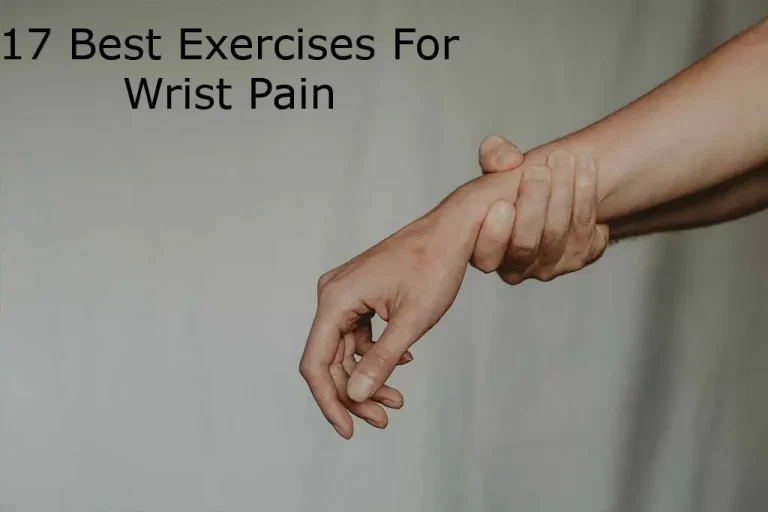
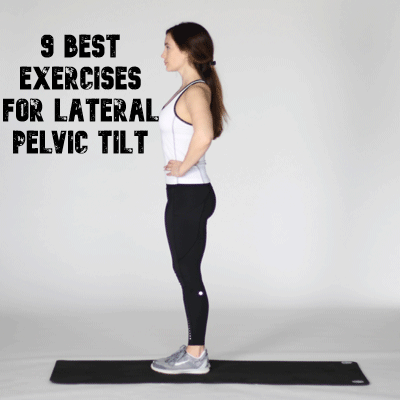
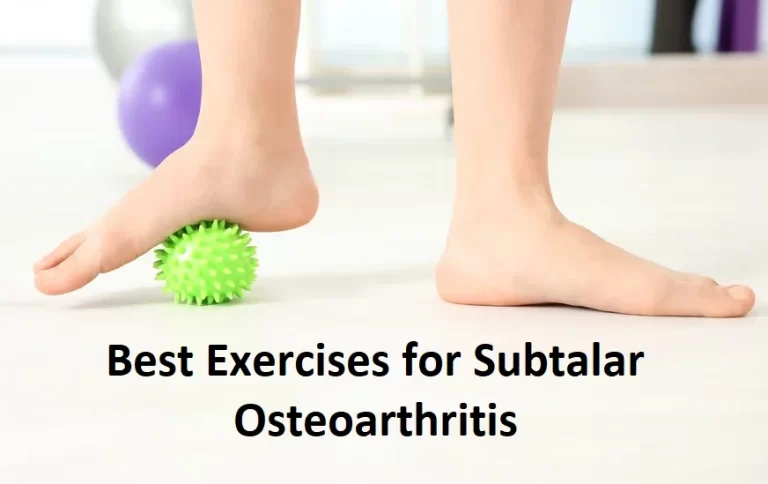
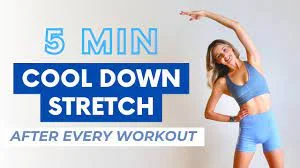
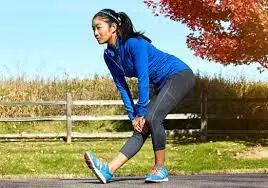
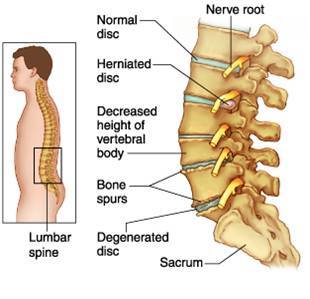
4 Comments